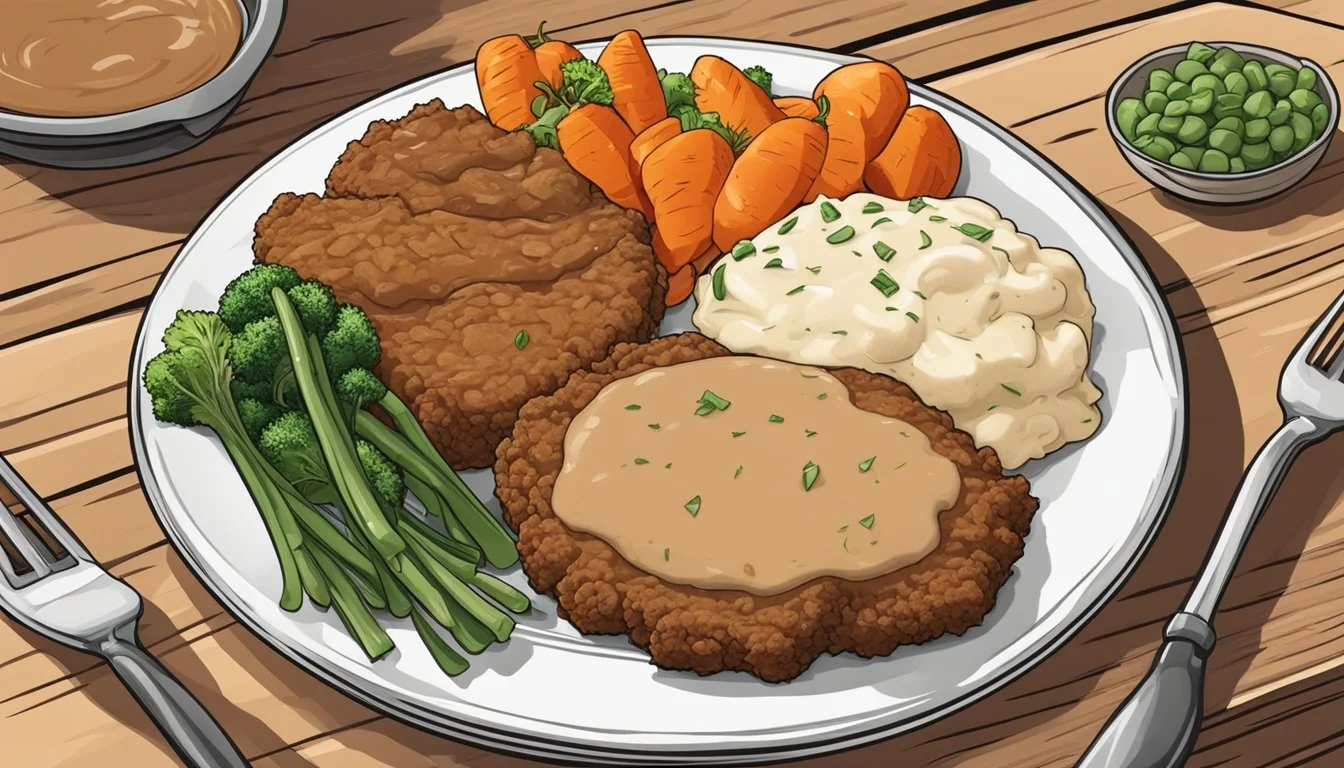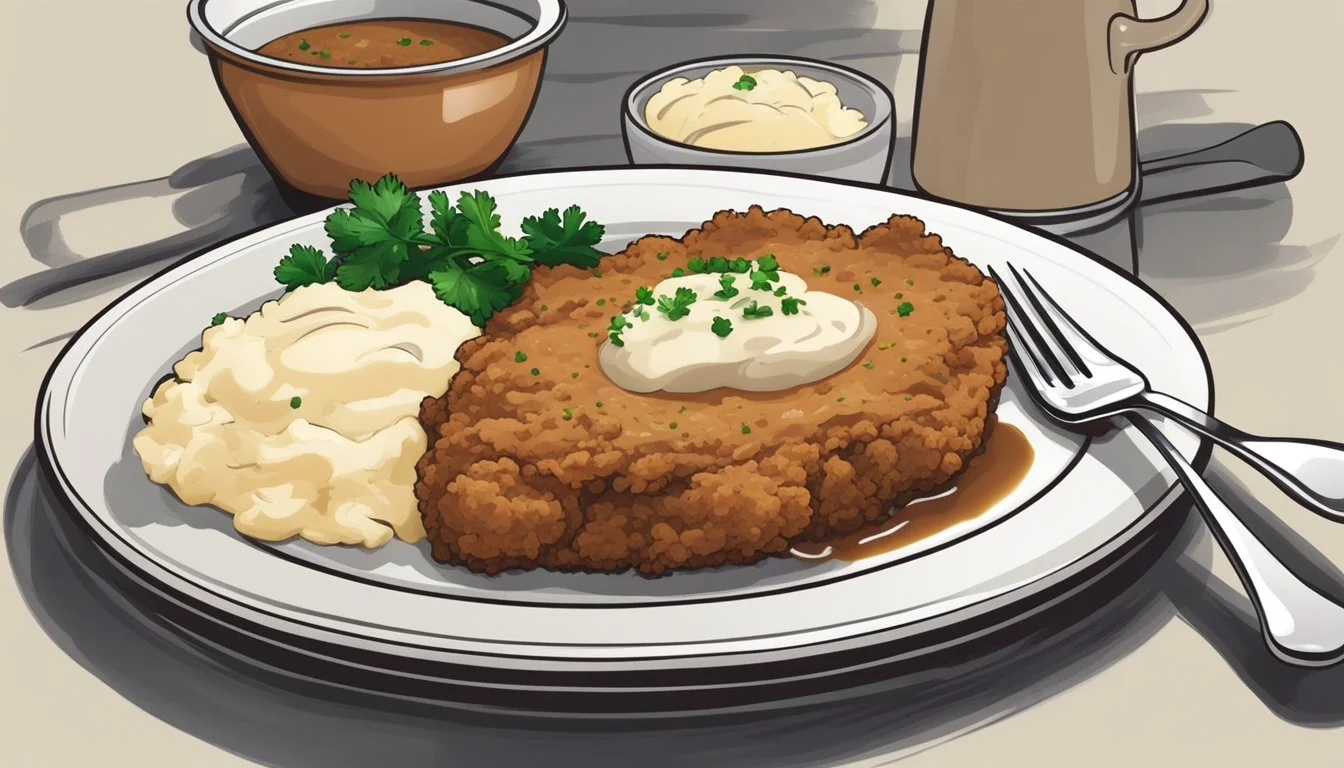How Long Does Chicken Fried Steak Last?
Tips for Proper Storage and Shelf Life
Chicken fried steak is a beloved comfort food known for its tender meat and crispy breading. But how long does it last once you've cooked up this delicious treat? Chicken fried steak can be stored in the refrigerator for about 3 to 4 days if kept in an airtight container. This ensures that it remains fresh and safe to eat during that period.
For those who might want to extend the shelf life of their chicken fried steak, freezing is a great option. When properly wrapped and stored in an airtight container, it can last up to 2 to 3 months in the freezer. This makes it convenient for meal prepping or having a quick meal ready for those busy days.
Proper storage and reheating are crucial to maintaining the texture and flavor of your chicken fried steak. When reheating, it's best to use an oven, as it helps to keep the steak crispy, unlike the microwave, which can often make it soggy.
Understanding Chicken Fried Steak
Chicken Fried Steak is a beloved dish with a rich history and notable differences from similar cuisines. It's often associated with Southern comfort food, combining flavorful breaded beef with a crispy exterior.
Origins and Cultural Significance
Chicken Fried Steak is believed to have originated in the Southern United States. The dish likely developed from the cooking traditions brought over by German immigrants who introduced Wiener Schnitzel. Unlike traditional Schnitzel, which typically uses veal or pork, Chicken Fried Steak is made from cube steak—a tenderized cut of beef.
The cultural significance of Chicken Fried Steak is deeply rooted in Southern cuisine. It is often served as a hearty meal, accompanied by rich gravies and side dishes like mashed potatoes. Its popularity grew as a form of comfort food, frequently enjoyed at diners and home kitchens.
Comparing Chicken Fried Steak With Country Fried Steak
Though often confused with Chicken Fried Steak, Country Fried Steak has distinct characteristics. Both dishes use breaded beef, but the breading ingredients and cooking methods vary.
Chicken Fried Steak typically features a flour-based breading and is fried until crispy, resembling Fried Chicken in texture. The dish is usually served with a white pepper gravy.
In contrast, Country Fried Steak is commonly breaded in a combination of flour and cornmeal or bread crumbs. It's fried and then simmered briefly in gravy, resulting in a dish that is less crispy and has a more tender exterior. The gravy for Country Fried Steak is often brown and includes onion or mushroom flavors.
Each dish, with its unique preparation and presentation, reflects regional preferences and culinary traditions.
Essential Ingredients
Creating a delicious chicken fried steak starts with selecting high-quality meat and ensuring it is properly breaded and seasoned. The choice of oil for frying also plays a crucial role in achieving the perfect texture and flavor.
Choosing the Right Type of Meat
The best chicken fried steak often uses tenderized cuts of beef, such as cube steak. Cube steak is preferred because it is already mechanically tenderized, making it easier to chew and enjoy. If cube steak is not available, round steak can be tenderized at home using a meat tenderizer.
The meat should be fresh and well-trimmed to remove any excess fat. A consistent thickness helps ensure even cooking.
Breading and Seasoning
For the breading, all-purpose flour is commonly used, often enhanced to become seasoned flour with salt, black pepper, garlic powder, and other spices like onion powder and paprika.
Eggs and buttermilk form the wet component, helping the flour adhere to the meat. The steaks are typically dredged in flour, dipped in the buttermilk mixture, and then dredged in flour again. This double-dredging process creates a crisp and flavorful crust.
Adding cornstarch to the flour can increase the crispiness. Cayenne pepper may be included for a bit of heat.
Types of Oil for Frying
Choosing the right oil is essential for a successful chicken fried steak. Vegetable oil, canola oil, and peanut oil are common choices due to their high smoke points.
A heavy skillet, preferably cast iron, is ideal for frying the steaks evenly. The oil should be heated to around 325°F to 350°F before adding the meat. This ensures the steaks fry properly without becoming greasy. Using a thermometer can help maintain the correct temperature.
Preparation Techniques
The preparation of chicken fried steak begins with tenderizing the meat and continues with coating and breading, culminating in various frying methods that ensure a crispy and flavorful result.
Tenderizing the Steak
Tenderizing is crucial for chicken fried steak, as it involves breaking down the tough fibers of the beef. Typically, a meat mallet is used to pound the steak to a consistent thickness, roughly 1/4 inch thick.
This not only makes the steak more tender but also helps it cook evenly.
Use the flat side of the mallet for best results. It’s essential to place the steak between two pieces of plastic wrap or wax paper to prevent mess and contamination. Some cooks might prefer using a tenderizing tool that punctures the meat, but the mallet remains the most traditional and effective method.
Coating and Breading
The coating process is what gives chicken fried steak its signature crispy crust. Start by setting up a breading station with three dishes: one with flour mixed with salt, pepper, and optional seasonings such as paprika or garlic powder; a second dish with beaten eggs and milk; and a third dish with a flour mixture enhanced with baking powder and baking soda.
First, dredge the tenderized steak in the flour mixture, ensuring it is fully coated. Then dip it into the egg mixture, allowing the excess to drip off before returning to the flour for one more thorough coating. This double-dipping method ensures the breading sticks well to the steak and creates a hardier crust.
Frying Methods
Frying chicken fried steak requires hot oil, ideally maintained at 325°F to 350°F, ensuring even cooking without burning. A cast-iron skillet or a Dutch oven is perfect for frying, as they retain heat consistently. Fill the pan with about 1/4 inch of vegetable oil, canola oil, or peanut oil, depending on your preference.
Carefully place the coated steak into the hot oil, cooking each side until golden brown, usually about 3-4 minutes per side.
For a deep-fried variation, the steak can be submerged completely in hot oil, which may result in a more uniform crust. Once fried, place the steaks on a wire rack to drain excess oil and maintain crispiness.
Cooking the Perfect Chicken Fried Steak
Cooking the perfect chicken fried steak involves mastering the right techniques to achieve a crispy coating, avoiding common frying mistakes, and maintaining the ideal temperature and times. Precision in these areas can result in a steak that is both flavorful and tender.
Achieving Crispy Coating
To achieve a crispy coating, follow a thorough dredging process.
Start by coating the steak in seasoned flour, ensuring the meat is well-covered.
Then, dip the floured steak into a buttermilk mixture (combine buttermilk, eggs, and salt), making sure it is fully immersed. Finally, dredge the steak in flour again, pressing gently to ensure a firm coating.
This double dredging method ensures that the coating adheres well and crisps beautifully during frying. Using a well-seasoned flour mixture with salt and pepper adds to the flavor.
Avoiding Common Frying Mistakes
Avoiding common frying mistakes is crucial.
Do not overcrowd the skillet; this can cause the oil's temperature to drop, leading to soggy steaks.
Use a large, heavy skillet like a cast-iron to maintain consistent heat. Ensure the oil is hot enough; it should be around 350°F and should sizzle when a few drops of water are sprinkled into it.
Always let excess oil drip off on a wire rack instead of paper towels to maintain crispiness.
Cooking Temperature and Times
Maintaining the right temperature and timing is essential for a perfect fry.
Heat the oil to a consistent 350°F. Fry each steak for about 3-5 minutes per side, or until they reach a golden brown color.
Check for doneness by cutting into the thickest part of the steak; it should be cooked through without a pink center.
Use a thermometer to ensure the oil remains at a stable temperature. Adjust the heat if necessary to avoid burning the coating or undercooking the meat.
Serving and Side Dishes
Chicken fried steak is often paired with rich gravies and hearty side dishes that complement its crispy, savory flavor. The choice of gravy can greatly influence the meal, while traditional sides add both taste and nutritional balance.
Gravy Varieties
Gravy is a staple accompaniment for chicken fried steak, enhancing its flavor and texture. Cream gravy is classic, made from pan drippings, milk, and flour, offering a smooth and rich consistency. It's favored for its mild taste, which pairs well with the seasoned breading of the steak.
Brown gravy, slightly more savory, uses beef broth for a deeper flavor profile that complements the crispy, seasoned coating. White gravy, similar to cream gravy but with a lighter appearance, often includes black pepper for extra zest. Each gravy variety offers a unique twist to the dish.
Traditional Side Pairings
Traditional side dishes provide both nutritional balance and complementary flavors. Mashed potatoes, especially when enriched with butter, are a classic choice, offering a creamy texture that pairs well with the crispness of the steak. Green beans, often sautéed in butter and garlic, add a fresh, vibrant dimension.
Collard greens deliver a nutritious, slightly bitter taste that contrasts nicely with the rich steak. Cornbread and biscuits are excellent bread options that soak up the gravies. For a Southern flair, fried okra and black-eyed peas bring authenticity and additional textures to the meal.
Country fried steak fans might enjoy blending these sides for a complete, satisfying dining experience.
Storage Recommendations
Proper storage is essential for maintaining the freshness and quality of chicken fried steak. Guidelines for both refrigeration and freezing will ensure your meal lasts as long as possible without compromising safety or taste.
Refrigeration Best Practices
When storing chicken fried steak in the fridge, proper wrapping is crucial. Use airtight containers or tightly wrap the steak in aluminum foil or plastic wrap. Store it in the coldest part of the fridge, typically the back or bottom shelf.
Chicken fried steak can be kept in the refrigerator for 3 to 5 days. If it remains in the fridge longer than this period, it may begin to spoil. Ensure that the refrigerator is set to a temperature of 32°F to 40°F (0°C to 4°C) to prevent bacterial growth.
If reheating is necessary, ensure the steak reaches an internal temperature of 165°F (74°C) to ensure safety. Use a food thermometer to check this. Avoid reheating multiple times as this can degrade the quality.
Freezing and Thawing Tips
For longer storage, chicken fried steak can be frozen. Wrap the steak tightly in plastic wrap or aluminum foil, then place it in a resealable freezer bag. This helps to prevent freezer burn. Label the bag with the date to keep track of how long it has been stored.
Frozen chicken fried steak can last for up to 3 months with minimal quality loss. To thaw, move the steak to the refrigerator 24 hours before you plan to eat it. This slow thawing process helps preserve texture and flavor.
When reheating frozen steak, use an oven or air fryer rather than a microwave. This prevents the steak from becoming soggy. Ensure it reaches an internal temperature of 165°F (74°C) prior to consumption.
Nutritional Information
Chicken Fried Steak is a popular Southern dish. It is essential to consider its nutritional components when including it in your diet.
A typical serving can vary in calorie content. Some sources indicate around 612-982 calories per serving. The variation depends on preparation methods and portion size.
Macronutrients
Total Fat: Depending on the recipe, total fat ranges from 32g to 70g.
Saturated Fat: Approximately 10g per serving.
Trans Fat: About 1.1g.
Polyunsaturated Fat: 6.4g.
Monounsaturated Fat: 12g.
Protein
Protein content in chicken fried steak is usually around 20-25g per serving. This helps in muscle repair and growth.
Cholesterol and Sodium
Cholesterol: Chicken fried steak contains significant cholesterol levels, typically around 150-200mg per serving.
Sodium: The sodium content can be high, often ranging from 900-1500mg, making it necessary to balance with low-sodium days.
Other Nutrients
It includes small amounts of vitamins and minerals such as iron and potassium.
The carbohydrate content is generally low, primarily coming from the breading and gravy.
Example Nutrition Data
Nutrient Amount Per Serving Calories 612-982 Total Fat 32g-70g Saturated Fat 10g Trans Fat 1.1g Cholesterol 150-200mg Sodium 900-1500mg Protein 20-25g
Suggestions for Leftovers
Leftovers can be a great way to save time and reduce waste. Proper storage and creative reuse can extend the life of your chicken-fried steak and make it just as delicious the second time around.
Creative Ways to Reuse Leftover Steak
Sandwiches and Wraps: Shred the leftover steak and serve it inside a sandwich or wrap. Adding fresh vegetables, a touch of mayo, or even some lumpy gravy can create a tasty, easy meal.
Salads: Slice the chicken-fried steak into thin strips and toss it onto a bed of greens with your favorite dressing. Adding Texas Roadhouse Rolls on the side can complement the meal perfectly.
Breakfast Hash: Dice the steak and mix it with diced potatoes, onions, and bell peppers. Sauté the mixture, and add an egg on top for a hearty breakfast.
Tacos: Warm up the steak and put it inside a taco shell with some salsa, avocado, and cheese. A squeeze of lime can add a refreshing flavor.
Making Leftovers Last
Refrigeration: Store the chicken-fried steak in an airtight container and refrigerate it within two hours of cooking. It will last in the fridge for up to four days.
Proper Reheating: Reheat the steak gently to avoid drying it out. Use an oven set to 350°F, an air fryer, or even a microwave set to a low power setting. Covering the steak with a damp paper towel can help maintain moisture.
Freezing: If you don't plan to use the leftovers within four days, freeze the steak. Wrap it tightly in plastic wrap or aluminum foil, then place it in a freezer bag to prevent freezer burn. Properly stored, it can last in the freezer for up to three months.
Avoiding Contamination: Always use clean utensils and containers when handling leftovers. Reheat only the portion you plan to eat, as repeated reheating can encourage bacterial growth.










